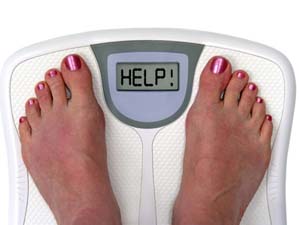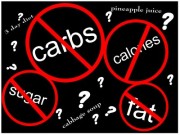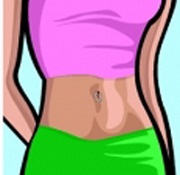 The following article is a small excerpt from one of my books. I hope you’ll want to learn more and let me help you to get into the best shape of your life.
The following article is a small excerpt from one of my books. I hope you’ll want to learn more and let me help you to get into the best shape of your life.

THE MYTH:
TO LOSE WEIGHT, CUT CARBS OR FAT
THE TRUTH: Most get-thin-fast plans revolve around the idea that restricting your intake of one particular nutrient, usually carbs or fat, is the best way to lose weight. But the results of recent studies suggest otherwise. For two years, participants followed one of four calorie-restricted diets with varying amounts of carbs, protein, and fat. After 2 years, all participants lost about the same amount of weight (just nine pounds). This study proves that calories are the most important factor for weight loss. To lose weight, you need to take in fewer calories than you burn regardless of what percentage of carbs, protein, or fat you’re eating. Gimmicky diets just distract you from this simple truth. Here’s how you can learn to reduce your total calorie intake to kick start weight loss and still have energy.
FIND YOUR CALORIE BURN
To estimate the number of calories you use during daily living and exercise, go to my website www.globalhealthandfitness.com and click on diet and fitness calculators and than click on calories for men calformales or calories for women calsforfemales Plug in your sex, age, weight, height, lifestyle (meaning, you’re deskbound, or you’re always moving at work), and exercise regularity. This will give you the number of calories you need to eat daily to maintain your body weight. There are also several metabolism formulas in my books.
START SUBTRACTING
Trim 10 to 15 percent off of that calorie total but don’t cut more than 500 calories per day. This is conservative compared to most diets, but it’s realistic. Record what you eat, and tally your calorie intake. You can use the food data base that is in my book ‘Get Fit Stay Fit’ or there are others available on line.
KEEP UP THE EXERCISE
A recent study reported that subjects who cut calories or cut calories and exercised lost the same amount of weight. But the diet-and-exercise group improved their aerobic capacity, insulin sensitivity, cholesterol, and blood pressure without having to go into starvation mode.
BE PATIENT
A healthy weight-loss goal is one to two pounds a week. Trying to drop more than this can eat away at muscle, leave you fatigued, and slow your metabolism, making weight loss more difficult.
A smart weight-loss plan
CARBS: 50 to 55 percent of total calories
Why You Need It: Your body prefers carbs as your main fuel source, so they should be the cornerstone of your diet.
Fruits, vegetables, whole grains, beans, and lentils are rich in complex carbs and fiber (both slow digestion and supply a steady stream of energy), as well as vitamins, minerals, and antioxidants that speed recovery and protect against diseases.
FAT: 25 to 30 percent of total calories
Why You Need It: You need this nutrient to absorb fat-soluble vitamins; foods high in fat also keep you satisfied, so you eat less.
Nuts, seeds, and avocados are rich in heart-healthy mono- and polyunsaturated fats. Olive oil contains oleic acid, and may help suppress your appetite. Other healthy choices include canola, grape seed, flaxseed, and hempseed oils.
PROTEIN: 15 to 25 percent of total calories
Why You Need It: Protein speeds muscle repair and recovery. High-protein foods are satisfying and take longer to digest.
Cuts of beef and pork labeled “loin” and skinless poultry have a healthy protein-to-fat ratio. Fatty fish are rich in omega-3s. Tofu is a lean protein source, while low-fat dairy like milk and yogurt provide calcium. Eggs are loaded with vitamins A, K, and D.
THE MYTH:
EXERCISE IN THE FAT-BURNING ZONE
THE TRUTH: The “fat-burning zone” lies between 50 and 70 percent of your maximum heart rate. When you exercise at this low intensity, your body draws energy from fat. As your heart rate goes up, more energy comes from carbs. So it seems logical that to lose fat you should keep your heart rate low, but this is not the case.
Exercising at higher intensities causes you to burn a lower percentage of fat calories in favor of carbs, but you use more total calories, and that’s the key to slimming down. Plus, since you burn more total calories, the absolute amount of fat burned actually increases, too. So it pays to pick up the pace.
Of course, lower intensity exercise still has its place. Long, slow runs build aerobic fitness and endurance. But to kick start a slow metabolism, you need intensity. Interval training (condensed runs that mix in intense efforts with recovery) have found these workouts burn more calories during and after exercise.
High-intensity intervals will help you win the battle of the bulge.
ON THE TRACK: Warm up for 10 minutes. Run 800 meters, aiming to finish the interval at 90 to 95% of your max heart rate. After a two-minute recovery jog, repeat two more times, and then cool down for 10 minutes. Add an 800-meter interval every two weeks until you reach six.
ON A TREADMILL: Warm up for 10 minutes. Run for five minutes with treadmill at 1% incline at a speed that hits 90 to 95% of your max heart rate. After a two-minute recovery jog, repeat two more times. Cool down for 10 minutes. Add one interval every two weeks until you reach six.
ANAEROBIC CAPACITY: Warm up for 10 minutes. Do six 400-meter runs (or about 90 seconds on a treadmill) at your mile race pace or slightly faster. The interval should be considerably faster than the previous workouts. Between each interval, complete a two-minute recovery jog.
TO GAUGE MAX HEART RATE: Run four laps on a track with each lap getting faster. On last lap, sprint as hard as you can. Check your heart-rate monitor. The highest number will be close to your max.
THE MYTH:
MINI-MEALS ARE BETTER THAN THREE HEARTY ONES
THE TRUTH: Many dieters believe eating several small meals a day is a guaranteed way to quash hunger. But scientists have not turned up substantial evidence that eating frequency really matters. In fact, a 2009 study with more than 10,000 subjects reported that between-meal nibblers were 69 percent more likely to pack on pounds over five years. Frequent eating only works if you choose nutritious foods and control portion sizes, after all, it’s not hard to turn six small meals into six large ones. It all comes back to calories. You can eat three times a day or 10, as long as you have the same calorie intake that will induce weight loss.
Eating something small pre workout followed by a post workout snack or meal can improve performance and recovery. If you workout at lunch, nibble on some dried fruit or yogurt before, and eat a mix of carbs and protein afterwards like a turkey sandwich. For the rest of the day, let your hunger be your guide when to eat.
THE MYTH:
LIFT LESS WEIGHT WITH MORE REPS TO GET TONED
THE TRUTH: Most think that to look lean and toned you have to skip heavy barbells in favor of lighter weights with lots of repetitions. But that won’t give you the physique you are looking for. To get toned, you need larger muscles and less fat and challenging your body through heavier lifting is a big part of this equation. Lifting 85 percent of your maximum ability for eight reps burns about twice as many calories in the two hours post workout compared with 15 reps at 45 percent your body max. Don’t worry, lifting heavy weights won’t transform you into a bodybuilder. Achieving that look requires eating a high-calorie diet and a long-term power-lifting regimen. If you’re creating a calorie deficit, you simply won’t bulk up like a bodybuilder.
You don’t have to give up lighter weights with high reps because they do a better job at improving your muscular endurance. Your program should include both high and low reps. Doing higher reps (12 to 15) and lower weights for about four weeks and then switch to lifting heavier weights for fewer reps (8 to 10) for four weeks, will keep the stress on your body constantly changing. Remember muscle responds to resistance, so if it’s too light, you won’t see good results.
THE MYTH:
YOU CAN “MAKE UP” WEEKEND SPLURGES
THE TRUTH: The weekend represents about 30 percent of the week, and in a recent study dieters who dropped pounds during the week, but stopped losing weight by feasting on whatever they wanted on the weekend, would cancel out five days worth of healthy eating
When it comes to shedding pounds, consistency is the key. Aim to consume a similar number of calories on Tuesday as you would Saturday. If you weigh yourself Friday and again Monday any weight gain is a sign you shouldn’t have eaten the extra slice of pizza.
Here are some tips to help you survive the weekend
THINK AHEAD
When traveling to events bring your own healthy edibles like oatmeal and trail mix.
WRITE IT DOWN
Keep a food journal which can help you lose almost double the weight of non writers.
DON’T SKIP YOUR CHEERIOS
Eat a hearty morning meal daily and you will eat fewer calories later in the day.
GIVE IN
Have a few treats during the week so once Saturday comes, you won’t feel the desire to binge.
THE MYTH:
YOU HAVE TO BAN “BAD” FOODS
THE TRUTH: People trying to slim down often try to cut out all indulgent foods, but eventually, this approach usually backfires. If you’re following an overly restrictive diet, you’re more likely to go overboard on your vices. Flip-flopping between a diet that includes sweet treats and one that banishes them (in other words, yo-yo dieting) activates your brain’s stress system, making you want to gorge even more.
So before you cut out your favorite foods, ask yourself: Can I live without cheesecake (or potato chips) forever? The answer is probably no. Losing pounds and keeping them off, depends on learning to balance your diet without depriving yourself, and eating in a way you can maintain. Eat great 80 percent of the time, and allow room for small treats the other 20 percent. As long as you’re reducing your overall intake, you don’t need to stop eating any one food from your diet.
A PERFECT DAY OF EATING
Here’s how to gauge what your diet should look like.
35 years old, 150 pounds
Lifestyle Sedentary desk job
Exercise Runs about 20 miles per week and strength trains about two hours per week
Maintenance Calorie Needs 2,387 calories per day
Goal Calorie Intake 2,029 calories (15 percent reduction)
Breakfast
2 slices whole-grain toast; 2 teaspoons almond butter; 1 kiwi; 1 hard-boiled egg
A breakfast containing a balanced mix of carbs, protein, and healthy fats prevents overeating during the day.
Morning Snack
1 cup plain low-fat yogurt; 1/2 cup raspberries; 1 ounce sunflower seeds
Have a midmorning snack to hold off hunger while providing energy for your lunchtime workout.
Lunch Workout
30- to 40-minute interval run
Post workout
1 cup low-fat chocolate milk
It provides an ideal mix of quick-digesting carbs and protein to promote recovery. Plus, the chocolate helps satisfy occasional sweet cravings.
Lunch
1 serving (2 cups) Pasta Bean Toss; 1 medium apple
Make this no-fuss recipe (below) for dinner the night before and pack the leftovers for lunch.
Dinner
4 ounces chicken breast; 1 cup cooked quinoa; 1 cup multicolored salad of an avocado; 1 tablespoon extra-virgin-olive-oil-and-vinegar dressing
The healthy fat in olive oil and avocado slows digestion (keeping you satisfied) and boosts the absorption of antioxidants in veggies.
Evening Snack
3 cups air-popped popcorn
When air-popped, it makes a tasty and healthy whole-grain, low-calorie snack for the evening.
TOTAL CALORIES: 1,991; CARBS: 252g; FIBER: 47g; PROTEIN: 113g; FAT: 67g
35 years old, 175 pounds
Lifestyle sedentary desk job
Exercise Runs about 20 miles per week; strength trains about two hours per week
Maintenance calorie needs 3,033 calories
Goal calorie intake 2,578 (15 percent reduction)
Pre workout Snack
1/2 cup plain low-fat yogurt; 1/3 cup blueberries; 1/4 cup raisins
To recharge your muscles following an overnight fast, have a small breakfast that’s easy to digest.
Morning Workout
45-minute run
Post workout Breakfast
2 hard-boiled eggs; 1 1/2 cups plain oatmeal mixed with: 1 medium banana (sliced), 1 ounce walnuts, 2 teaspoons maple syrup
Eggs are an easy way to get protein to speed recovery after a morning run. A bowl of oatmeal with a banana and maple syrup helps reload muscle glycogen stores.
Lunch
Sandwich made with: 2 slices 100 percent whole-wheat bread, 2 ounces sliced turkey breast deli meat, 2 slices tomato, 1/2 cup baby spinach, 1 teaspoon Dijon mustard; 1 apple; 1/2 cup sliced red pepper; 1/2 cup baby carrots
Make sure to include plenty of fruits and vegetables with lunch to make it more filling, which will prevent overeating later on. Also, choose higher fiber whole grain bread.
Afternoon Snack
1 cup grapes; 6 whole-grain crackers; 1 ounce low-fat cheddar cheese
An afternoon snack will keep your energy high during a post work out exercise session.
After work
45 minutes weight training
Split workouts can boost intensity, make exercise more fun, and help you fit it into a busy schedule.
Post workout Shake
1 cup skim milk; 1/2 cup plain yogurt; 1/2 cup frozen strawberries; 2 teaspoons natural peanut butter
Make the shake in the morning and bring it with you. And pass on “reduced-fat” peanut butter. Most have similar calories and more sugar than regular PB.
Dinner
1 serving Lentils with Grilled Salmon; 2 cups multi-colored salad; 2 teaspoons extra-virgin olive oil; 1 medium orange
Salmon is packed with anti-inflammatory omega-3s. An orange provides a healthy, sweet dessert.
Evening snack
1 ounce dark chocolate
Have treats, such as dark chocolate, once in a while to avoid feeling like you’re depriving yourself.
Total Calories 2,544; Carbs 336g; Fiber 50g; Protein 121g; Fat 93g
THE MYTH:
EATING AT NIGHT CAUSES WEIGHT GAIN
THE TRUTH: Many believe their metabolism plummets later in the day, which is when we often over eat nutritionally corrupt foods. But a calorie is a calorie no matter when you eat it. As long as you don’t take in more calories than you burn in a day, you won’t gain weight. Overeating at 9 p.m. is essentially no worse than overeating at 9 a.m. You may have a slightly higher metabolism earlier in the day, but the impact on weight loss is likely trivial.
And if you train in the evening, eating at night is a must: You have to eat a well-balanced meal to encourage recovery no matter how late it is. As long as you don’t gorge, you’re not in danger of gaining weight. But if you routinely spend too much time with ice cream at night, you’re going to sabotage your efforts.
How to ward off night time over eating
SNACK IN THE AFTERNOON
A lot of people don’t eat enough after lunch, leaving them ravenous at night. Eat whole-grain crackers and low-fat cheese, or plain yogurt with fruit mid afternoon to avoid getting intimate with Haagen-Dazs later.
GET POPPING
Try low-fat popcorn for nighttime finger food. It’s a high-fiber whole grain, and one cup has just 31 calories.
EAT FOOD IN THE KITCHEN
you are more likely to overindulge when parked in front of the boob tube, which distracts you from noticing how much you’re eating so eat at a kitchen table.
WALK THIS WAY
a 15-minute walk after eating weakened chocolate cravings in people who abstained for three days. Make an after dinner stroll routine.
PLAN MEALS
Coming home famished after a workout without a dinner plan can lead to grabbing the nearest bag of Doritos. Having a meal made ahead of time you can easily heat up or a few quick go-to recipes can ensure you make healthy choices.
THE MYTH:
LOW-FAT FOODS ARE A HEALTHY CHOICE
THE TRUTH: Eating low-fat foods has helped make the nation look more like the Pillsbury Doughboy. Reason being, a low-fat or reduced-fat item may have nearly as many calories as a higher-fat version because ingredients like sugar often replace the fat to make the product taste better, Low-fat foods can still contain unhealthy saturated or trans fats both of which may increase your risk of heart disease.
People also eat 28 percent more treats when they were portrayed as “low-fat” rather than “regular.” Low-fat labels (like those on cookies and fruit-flavored yogurts) cause people to underestimate calorie consumption, increase the amount they eat, and temper the guilt of polishing off a box of reduced-fat Oreos. Some people see the term ‘fat-free’ and use it as a green light to eat as much of it as they want. This leads to over consuming calories and that, leads to weight gain.
Diet Busters
DIET SODAS
adults who drink diet sodas often are more likely to be overweight and develop diabetes.
WINE
It has health benefits, but also packs lots of calories. If you’re trying to slim down, keep it to one drink daily.
WHITE PASTA
It’s low in fiber and nutrients. Choose whole-grain versions most often.
ENERGY DRINKS AND BARS
They contain added sugar (i.e., empty calories), so scale back.
CHOCOLATE
A single ounce has about 160 calories. Limit yourself to that much (and choose dark varieties) per day.
THE MYTH:
WEIGHT LIFTING WILL ONLY BULK YOU UP
THE TRUTH: Many people blow off weights for cardio, a bigger calorie burner. They’re also afraid of getting bulky while trying to slim down. But if who want to slim down you need to pump iron. It makes you stronger and builds endurance, so you can run longer and harder, burning more calories for weight loss. Since muscle is denser than fat, you’ll also shave inches off your body and look leaner.
Plus, cutting calories can lead to losing lean body mass, and weight lifting helps preserve muscle, which is more metabolically active than fat. It takes extra calories just to keep muscle. Strength training may boost resting metabolic rate by as much as seven percent. And you don’t need to live at the gym to get results. Just 11 minutes of weight training three times a week will boost daily energy expenditure.
LIFT WEIGHT TO LOSE WEIGHT
SPEED WEIGHT LOSS, build strength, and improve running performance with this workout. Do the routine two to three times per week with at least one rest day in between. Begin with two to three sets of each exercise with 15 reps, using a challenging weight. After four weeks, switch to a heavier weight and complete three sets with 8 to 10 reps. Every four to six weeks, alternate between less weight, more reps and more weight, fewer reps. As you build up stamina, reduce the rest period between exercises to increase calorie burn.
SINGLE-LEG DEADLIFTS TO SHOULDER PRESS
Stand on one leg, holding a set of dumbbells by your side. Slightly bend knee with your back straight; bend forward, keeping weights by your sides. Slowly stand up, keeping a straight posture. Once completed, curl your arms into a shoulder press. Bring weights back to your sides. Repeat on the other side.
LUNGE WITH OVERHEAD TRICEPS EXTENSION
Stand in a lunge position holding one dumbbell overhead with both hands. Keeping your elbows shoulder-width apart, bend them and lower the weight behind your head as you lunge down. Lift the weight up as you straighten your legs. Do half the set with one leg in front and then switch sides.
PUSHUP TO JACKKNIFE
Roll forward on a ball so that your arms are in a pushup position and the ball is under the tops of your shins. Then, lift your hips up and bring your knees into your chest. Ideally, your hips will be directly over your shoulders. Bring your legs back to the starting position, and then do a pushup. Keep alternating pushups and jackknifes
BALL SQUATS TO BICEPT CURL
Place the stability ball in the curve of your lower back, then lean against a wall, holding dumbbells in both hands. With feet about hip-width apart, squat down (using the support of the ball and the wall behind you) and simultaneously do a biceps curl. When you squat down, your legs should form a 90-degree angle. Hold for a moment, and then return to the starting position.
BALL PULLOVERS WITH HIP RAISES
Position yourself on a stability ball with your head and neck supported on the ball like a pillow and your body in a tabletop position. Your feet should be under your knees, hip-width apart. Keeping arms straight, as if you’ve just completed a chest press, lower arms behind you and over your head until your upper arms are even with your ears. Slowly bring them back to the starting position. Then, lower your hips toward the ground and back up. Keep alternating pullovers and hip raises. You can also balance a dumbbell on your hips for an extra challenge.
THE MYTH:
RUNNING ON EMPTY IS A SMART WAY TO BURN EXTRA FAT
THE TRUTH: In theory, because your blood sugar and muscle carbohydrate levels are low after an overnight fast, running before breakfast forces your body to use fat as its main fuel. But exercising on an empty stomach is like trying to run your car without gas. You need carbs in your system to start your engine and to keep it going strong to burn more total calories. Not only do muscles prefer to run on carbs, but so does your brain. Exercising with brain fog reduces intensity and increases injury risk. Fueling up with 100 to 200 calories (of easily digestible carbs like fruit juice, yogurt, or dried fruit) about 30 minutes before a morning workout will cut down on post exercise hunger and curbs overeating.
THE MYTH:
YOU CAN SPOT-REDUCE FAT
THE TRUTH: Many people spend too much of their gym time doing a bazillion crunches in pursuit of rock-solid abs or banging out hundreds of reps on the inner and outer thigh machines to melt away stubborn fat pockets. But the only way you can spot reduce is with liposuction. When you exercise, your body taps into energy stores from everywhere, not just one place. By over exercising one area of your body, you raise the risk of suffering an injury. It’s good to have a strong core, but too many crunches can over tighten abdominals and lead to back problems. Targeting a particular body part no more than three times a week, and focusing on a balanced full-body program will help create a calorie deficit, and ultimately that’s the only thing that’s going to slim those thighs and trim your belly.
The Burning Question: Just how many calories did that workout burn?
Many people think running burns 100 calories per mile but this is only true if you weigh 139 pounds. To calculate your burn per mile, multiply your weight in pounds by .75. A 150 pound runner burns 112 calories per mile; a 120-pound runner burns just 90. And if you run faster, you don’t burn more calories per mile but you do burn more per minute.
The number this formula yields is your “gross” calorie burn. But it can be deceptive: Even if you didn’t run at all, you’d still burn calories. A 150-pound person burns about 68 calories an hour doing nothing. This is your basal metabolic rate, or BMR. When you subtract your BMR from your gross burn, you get your “net” burn. If you’re trying to maximize your burning efficiency, compare the net burn per minute of various activities. Walking burns far fewer calories per minute than running because it doesn’t require as much effort. But cyclists can go so fast that air resistance becomes a factor. Thus, cycling 24 mph burns much more than double the calories of cycling 12 mph. 150 pound runner burns 112 calories per mile. Now if he runs 5 miles in an hour his total burn would be 560 calories. Minus his 86 calories BMR his net calorie loss is 474 calories.
You can use the formulas below to determine your calorie-burn while running and walking. The “Net Calorie Burn” measures calories burned, minus basal metabolism. Scientists consider this the best way to evaluate the actual calorie-burn of any exercise. The walking formulas apply to speeds of 3 to 4 mph. At 5 mph and faster, walking burns more calories than running.
Your Total Calorie Burn/Mile Your Net Calorie Burn/Mile
Running .75 x your weight (in lbs.) .63 x your weight
Walking .53 x your weight .30 x your weight
On my site there is a calculator that suggests calories burned per activity.
THE MYTH:
LONGER EXERCISE SESSIONS EQUAL BETTER RESULTS
THE TRUTH: Running for an hour straight is a great calorie burner and will undoubtedly help shed pounds. But you might actually accrue more fitness and fat loss by occasionally breaking that hour-long workout into two half-hour runs or three 20- minute sessions. A person may run at a harder pace if tackling two shorter runs instead of a single longer one, so the cumulative calorie burn could be greater. Those who performed two separate 30- minute aerobic sessions burned more calories post workout compared with a single 60-minute trial.
Same-day split sessions to help overcome time constraints and boredom, and accumulate the same training volume with less injury risk. Doing a steady-pace, moderate-intensity run for one session and a more intense calorie burner, like interval training or hill running, the second time. Conversely, try a high-intensity morning run followed by an after-work weight-training session.
THE MYTH:
YOU CAN’T OVERCOME YOUR GENES
THE TRUTH: some people are more predisposed to have a slower metabolism. Others put on weight more easily or carry extra pounds in certain areas. Staying slim is not a hopeless battle. You can outsmart your genes and maintain a healthy weight. Case in point, 16 same-sex twin pairs (chosen because they had the same genetic makeup) where studied for decades and found that the twin who had been more physically active over a 32-year period accumulated 50 percent less belly fat than the twin who didn’t exercise. By running and exercising regularly, you’re already a step ahead in winning the battle against the bulge.
In my book ‘Get fit Stay FIT’ I give many options for working out combinations.
THE MYTH:
KEEPING IT OFF IS THE EASY PART
THE TRUTH: Many people think maintaining weight loss is easier than losing it in the first place. But you have to be diligent. Researcher has discovered that overweight subjects who had slimmed down over two years required an average of 40 minutes of exercise per day just to sustain a loss of 10 percent or more of their initial body weight. And that was in addition to closely watching what they ate. Those who committed less time to sweating it out or none at all were more likely to be back where they started. Weight loss is not something that happens and then you’re done with it, that’s why quick-fix programs hardly ever work long term.
THE MYTH:
HIGH-FRUCTOSE CORN SYRUP IS MORE FATTENING THAN SUGAR
THE TRUTH: High-fructose corn syrup (or HFCS) has been singled out as a main cause of America’s obesity crisis. But both HFCS and sucrose better known as table sugar are very close in chemical composition, and neither type of sweetener offers any nutritional value apart from empty waist-thickening calories. You’d likely become just as pudgy from eating an excessive amount of foods that contain regular sugar as you would from eating foods that contain an excessive amount of high-fructose corn syrup. You should read labels carefully and scale back your intake of highly sweetened foods, including sodas, energy drinks, baked goods, cereals, and even sports drinks. If you need to satisfy a sweet tooth, you should do so shortly after a workout when your muscles quickly soak up the sugar to replace spent energy stores.
THE MYTH:
A FAST-FOOD SANDWICH IS ALWAYS A HEALTHIER CHOICE OVER A FAST-FOOD BURGER
THE TRUTH: Both can be equally damaging to your weight-loss efforts. People consistently underestimate the calorie content of foods served at restaurants they see as “healthier” and in doing so are more likely to order calorie bomb sides such as large sodas and cookies. But eating out in general not just at fast-food places can put a damper on your weight-loss efforts. Dieters will often consumed up to 253 extra calories and 16 additional grams of fat on the days that they ate out. Trade in eating out for more home cooking. Preparing your own meals gives you a better shot at controlling calorie intake, and it lets you choose more nutrient-rich ingredients. Many chain restaurants put nutritional information on their Web sites, so if you do plan on eating out, check out their nutritional stats to find the healthiest choices.
THE MYTH:
WALKING WON’T DO MUCH TO HELP YOU LOSE WEIGHT
THE TRUTH: Taking extra steps every day can have an important cumulative calorie-burning effect. Adults ages 19 to 30 who were car-happy gained up to 15 pounds more over a 15-year period than those who used their own two feet more often to get around. To motivate yourself to walk more, invest in a pedometer. Using a pedometer can lead to significant decreases in body-mass index and blood pressure. Aim for 10,000 steps daily. That’s two and half miles of walking, which means you’ll burn an extra 250 calories every day. You can boost your chances of reaching the 10,000-step goal by walking to a coworker’s cubicle instead of e-mailing, trading in the elevator for the stairs, and parking at the farthest corner of the mall lot.
THE MYTH:
THE TREADMILL ACCURATELY CALCULATES YOUR CALORIE BURN
THE TRUTH: If you run on a treadmill, sway on an elliptical, or pedal a stationary bike, the number of calories you actually burn can be 10 to 15 percent lower than what’s displayed on the screen. That’s because most machines don’t take into account percent body fat, height, sex, age, resting heart rate, or if someone is holding onto the handles, which reduces workload. Also, the mechanical assistance of machines allows your body to do less work. That doesn’t mean you should totally ignore an exercise machine’s stats. Use the calorie readout as a barometer of your progress. If the number goes up from one session to the next for the same workout, you know you’re working harder toward your weight loss goals.
The 10 Rules of Weight Loss
- To lose 10 pounds of body fat a year, you need to eat 100 calories less per day. Cutting too many calories from your daily intake will sap your energy level and increase your hunger, making you more susceptible to splurging on high-calorie foods.2. Don’t skip breakfast. Eat within two hours of waking.3. In fact, eat more breakfast than you think you should. Trade in some of your dinner calories for more calories at breakfast.4. Don’t allow yourself to get hungry. Eat at least every four hours, and split a meal in half to make sure you properly fuel up pre- and post workout For example, eat part of your breakfast before your morning run (a banana) and the rest of your breakfast afterward (a bagel with peanut butter).5. Eat at least three kinds of food each meal from these four categories: breads, cereals, and grains; fruits and vegetables; low-fat dairy and soy; and lean meats, fish, and nuts. Breads, cereals, and grains should be the foundation of each meal, with protein as an accompaniment.
6. Shoot for a gradual loss of body fat. You’re more likely to put the weight back on (and more) if you drop weight too quickly.
7. Liquid calories add up fast and can lead to weight gain. Minimize the amount of sodas, juices, store-bought smoothies, sports drinks, coffee drinks, and alcohol you consume.
8. Eat closer to the earth, enjoying fruits, vegetables, and whole grains. Minimize the amount of processed foods you eat; they tend to offer less fiber and are less satiating.
9. If you can’t resist fast food, ask for nutritional information before you make your choices (or check in advance via restaurant Web sites). Avoid any menu items with the words fried, crispy and special sauce, which are guaranteed to be high calories.
10. Remember that the calories in the energy bars, sports drinks, and gels you consume during a run add up, even though you’re running. Consume them only as needed.
I know you want to get in shape and look great. Whatever your fitness goal…to slim down…gain muscle…tone your arms or flatten your tummy…I’m here to help you accomplish your goals and to improve your fitness level. If you have enjoyed this article and the many other free features on my site, and would like some more comprehensive information such as fitness books and CD’s to aid you in achieving your health and fitness goals, please visit my ONLINE STORE where you will find innovative natural health and beauty products to help you become the BEST YOU CAN BE !

 The following article is a small excerpt from one of my books. I hope you’ll want to learn more and let me help you to get into the best shape of your life.
The following article is a small excerpt from one of my books. I hope you’ll want to learn more and let me help you to get into the best shape of your life.

 What soap is to your body, laughter is to your soul.
What soap is to your body, laughter is to your soul. Laughter can ease pain. You use energy focusing on pain when you’re ill. When distracted by laughter, your focus shifts away from pain, you relax and your body gets a few minutes of relief. That doesn’t mean that therapeutic laughter has become mainstream medicine. It’s accepted as music is accepted.
Laughter can ease pain. You use energy focusing on pain when you’re ill. When distracted by laughter, your focus shifts away from pain, you relax and your body gets a few minutes of relief. That doesn’t mean that therapeutic laughter has become mainstream medicine. It’s accepted as music is accepted. The following article is a small excerpt from one of my books. I hope you’ll want to learn more and let me help you to get into the best shape of your life.
The following article is a small excerpt from one of my books. I hope you’ll want to learn more and let me help you to get into the best shape of your life. The following article is a small excerpt from one of my books. I hope you’ll want to learn more and let me help you to get into the best shape of your life.
The following article is a small excerpt from one of my books. I hope you’ll want to learn more and let me help you to get into the best shape of your life. The following article is a small excerpt from one of my books. I hope you’ll want to learn more and let me help you to get into the best shape of your life.
The following article is a small excerpt from one of my books. I hope you’ll want to learn more and let me help you to get into the best shape of your life. The following article is a small excerpt from one of my books. I hope you’ll want to learn more and let me help you to get into the best shape of your life.
The following article is a small excerpt from one of my books. I hope you’ll want to learn more and let me help you to get into the best shape of your life. The following article is a small excerpt from one of my books. I hope you’ll want to learn more and let me help you to get into the best shape of your life.
The following article is a small excerpt from one of my books. I hope you’ll want to learn more and let me help you to get into the best shape of your life. The following article is a small excerpt from one of my books. I hope you’ll want to learn more and let me help you to get into the best shape of your life.
The following article is a small excerpt from one of my books. I hope you’ll want to learn more and let me help you to get into the best shape of your life. The following article is a small excerpt from one of my books. I hope you’ll want to learn more and
The following article is a small excerpt from one of my books. I hope you’ll want to learn more and  let me help you to get into the best shape of your life.
let me help you to get into the best shape of your life. The following article is a small excerpt from one of my books. I hope you’ll want to learn more and let me help you to get into the best shape of your life.
The following article is a small excerpt from one of my books. I hope you’ll want to learn more and let me help you to get into the best shape of your life.